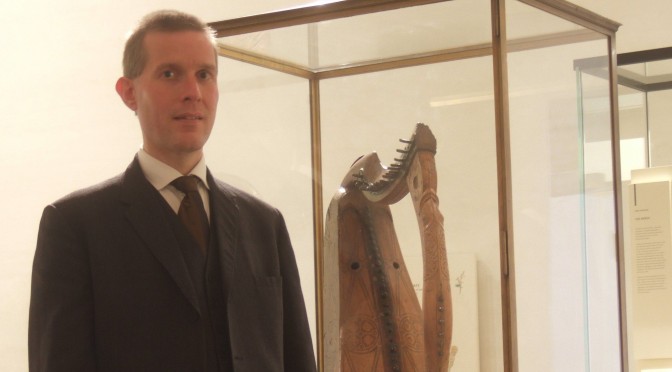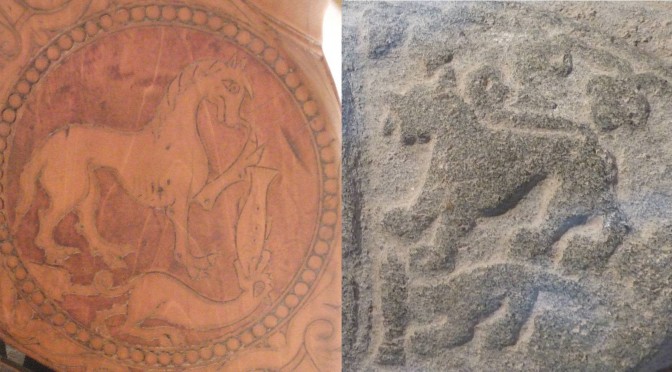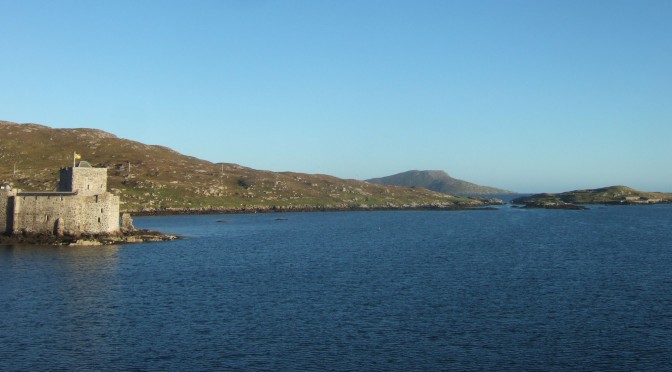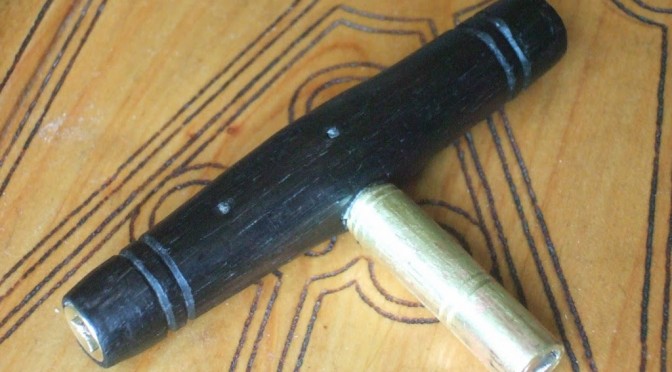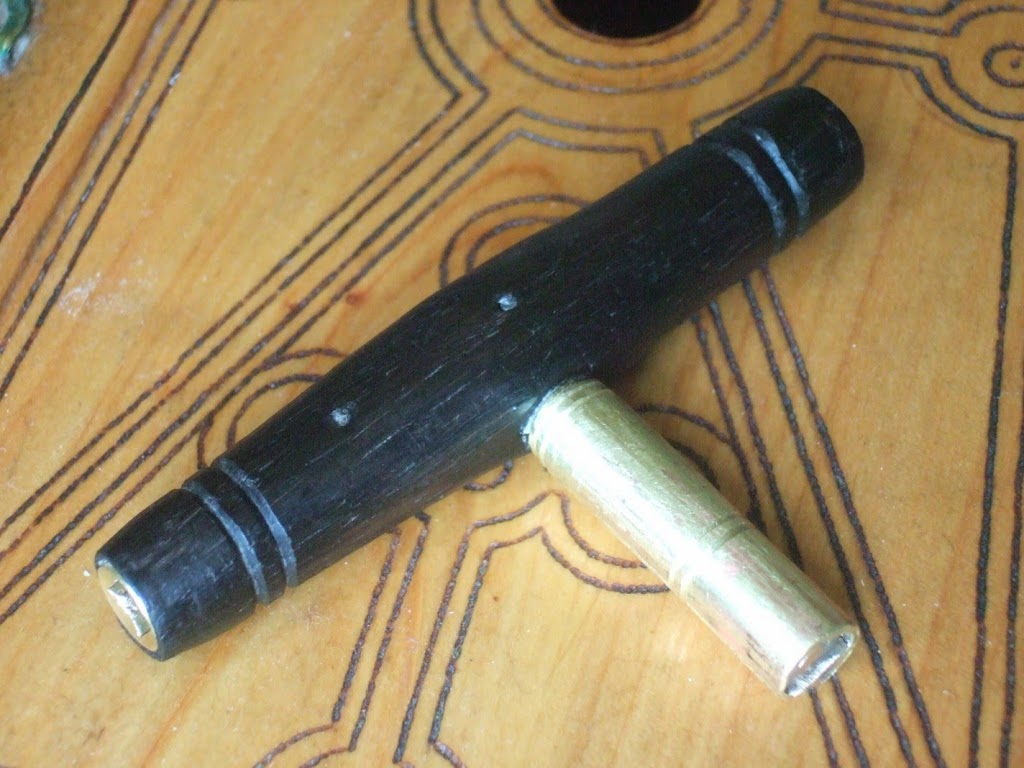For the next month, you can view the BBC TV documentary Scotland’s Treasures on iPlayer.
Tag: Queen Mary harp
Vermilion
Karen Loomis discovered the presence of mercury in the red pigment on the Queen Mary harp, when she did X-ray fluorescence analysis in 2010. This pretty much confirms that the pigment is vermilion, a mercury sulphide compound.
Karen reported that only the pigment on the curved body of the fish on the forepillar indicated mercury; the pigment on the flat panels of the forepillar contained no mercury. A rendering of the CT-scan data printed in her Galpin Society Journal article (vol LXV, 2012, p.166) shows high-density spots in the crevaces between the interlace of the fish shoulders, and also around the fish eye.
As soon as Karen told me about this I thought of re-painting my replica. Continue reading Vermilion
Events in Dundee, St Andrews and London
I am working hard this week, preparing for three events in three days. On Saturday I am in Dundee; on Sunday in St Andrews and on Monday in London.
West Highland heraldry
For a very long time I have been interested in the symbolism of the animals on the forepillar of the Queen Mary harp. In their book Tree of Strings – Crann nan Teud, Keith Sanger and Alison Kinnaird discuss these animals, suggesting that they may have religious symbolism: “We have examined the possibility of the designs having some family or clan significance but they do not seem to have any apparent links”
Playing the harp in Kisimul Castle
Steach gu Ciosamul an aighir,
Far a faighte cuirm ri gabhail
Ol fìon o oidhche gus an latha,
Pìobaireachd na feadan lagach,
‘s clàrsach bhinn ga gleusadh mar ris…
I was at Castlebay this past weekend, to play the harp at the Galley Castles Conference organised by the Islands Book Trust. I played three times for three different events during the conference, all of them fairly informal. Though I didn’t get a chance to formally present a paper on my research into the medieval Hebridean harp music and instrument tradition, I was pleased to be able to discuss my research and work with a number of interested academics working in this area on the history and archaeology of the castles and society of the medieval Western Isles and the Lordship of the Isles.
Ériú Harps
In August, Natalie Surina, of Ériú Harps, based in Oughterard, in Connemara in the West of Ireland, brought two new instruments along to Kilkenny for exhibition and sale. They were simplified copies of the medieval Scottish Queen Mary harp, Continue reading Ériú Harps
Fíor mo mholadh ar Mhac Dhomhnaill – medieval bardic poetry performance
This is the final set at the Ceòl Rígh Innse Gall concert in the museum at Armadale, Isle of Skye, last month: medieval Gaelic ‘bardic’ poetry, sung with accompaniment played on the replica of the medieval Scottish ‘Queen Mary’ harp.
Fíor mo mholadh ar Mhac Dhomnaill
Cur la gceanglaim cur gach comhlainn
True my praising of MacDonald, hero I am tied to, hero of every fight
Croidhe leómhain láimh nár tugadh
Guaire Gaoidheal aoinfhear Uladh
Lion’s heart, hand that did not reproach, Guaire of the Gael, sole champion of Ulster
Aoinfhear Uladh táth na bpobal
Rosg le rugadh cosg na cgogadh
Champion of Ulster, welder of people, eye which caused the ceasing of warfare
Grian na nGaoidheal gnúis í Cholla
Fa bhruach Banna luath a longa
Sun of the Gael, face of the sons of Coll, around the Bann his galleys were swift
Cuiléan confaidh choisgeas foghla
Croide connla bile Banbha
Furious hound, stopping raiders, steadfast heart, tree of Ireland
Tír ‘na teannail deirg ‘na dheaghaidh
A bheart bunaidh teacht go Teamhair
The land is a blazing beacon behind, his ancestral duty to go to Tara
Measgadh Midhe onchú Íle
Fréimh na féile tréan gach tíre
The confuser of Meath, the wolf of Islay, the root of bounty, the defender of each land
Níor éar aoinfhear no dáimh doiligh
Craobh fhial oinigh ó fhiadh n-Oiligh
Refusing no-one, no pleading poets, generous honourable branch from the land of Oileach
Níor fhás uime acht ríoghna is ríogha
Fuighle fíora fíor mo mholadh
No-one raised with him but kings and queens. True these judgements; true my praising
Poet: anonymous MacMhuirich c.1500
Singer: Gillebrìde MacMillan
harpist: Simon Chadwick
After the music finishes we hear Godfrey, Lord MacDonald, speaking with the ‘vote of thanks’.
Concert at Armadale
Here’s the first photo I have seen so far from the Ceòl Rígh Innse Gall concert at the Museum of the Isles, Armadale, on the Isle of Skye a couple of weeks ago.
“Like medieval clockwork” – copying the missing Queen Mary harp iron tuning pins.
When I was commissioning my replica of the Queen Mary harp in 2006, I paid attention to the 30th tuning pin, which is obviously a later addition, shorter, made of iron, split end, different drive, and off the main row. This pin is now missing but I made a copy of it based on descriptions and old photos. I made the 29 brass pins with their scores on their shafts copying the museum photo of the 21 pins now in the harp, and for the 8 missing pins I made the same design of brass pins without scores.
If I had been more on the ball back then I would have noticed that those same old photos and descriptions I used for the 30th pins, also show the missing 8 from the main row, and those missing 8 are plain iron not decorated brass, and 5 of them have split ends.
So today’s project was to make 8 handmade iron pins, and install them in the harp. The contrast of the iron and brass pins is subtle but interesting in appearance, reminding me of my initial reaction to the handmade decorated pins: “like medieval clockwork”.
I broke the lowest gold B string taking it off but there was enough spare to rewind the toggle and reuse it. The string had thinned where it went over the pin – presumably a gradual process over seven years since I fitted it in 2007.
Tuning key
I lost my tuning key in Edinburgh last weekend. At first I was rather irritated; the replica Queen Mary clarsach has handmade tuning key drives, copying the original, which are rectangular rather than the usual square. So the key is also custom-made with a rectangular socket, and also has a second socket in the end of the handle to fit the square drive of the 30th pin. Basically it is useless to anyone else! I did have a rather ill-fitting spare with me
However after a while I realised this was a great opportunity. I made this key not too long after the harp was new, and while it was comfortable to use with its roundwood quince handle from the garden here, the rectangular socket was always a bit oversized and was loose on all the pins. Also it was rather “rustic” in appearance.
So today I made a new key for the Queen Mary harp. This one builds on my experience making the first. The design is the same – a T shaped pin, with a brass socket made from a rod soldered inside a tube, the end of the rod slit with saw and files to fit the drives. The second socket, from a large clock key, fits in the end of the handle. Both sockets are fixed in with little brass pins running through the wood, and secured with glue to stop them shifting.
For the handle of this key I used a piece of ancient Irish bog oak which Davy Patton gave me years ago. I had thought of carving medieval West Highland designs into it, and even gilding the designs, but as the handle took shape it became very spare and elegant. The bog oak does not carve very cleanly anyway. So in the end the only decoration was a pair of parallel incised bands at each end of the handle and each end of the main socket shaft, echoing the pairs of incised bands on the Queen Mary harp tuning pins.
I have to make another soon as my student who has the Student Downhill harp has lost the key for it. It ought to have a brass socketed key anyway as the commercial steel-socketed key it used to have was starting to chew up the decorated brass pins I have started fitting to it. Which reminds me, I need to finish the set of brass pins for that harp. So many jobs lining up…


